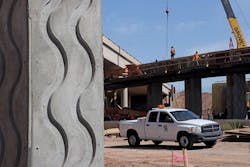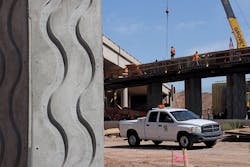By: Brad Guilmino and Adam Sheets
Ask someone about the industry’s adoption of public-private partnerships (P3s), and they may describe it as slow.
But is it really? Or is it a normal progression of a new delivery method? Design-build delivery took 30 years to go mainstream, and yet some states still have not embraced it.
Changing how the surface transportation industry has delivered projects for the past 100 years takes time. The practice of leveraging private-sector developers to finance, maintain and operate large transportation projects is only 15 years old. The fact that the U.S. sees an average of two large transactions per year is the normal course of adoption. Having said that, there are numerous indications the pipeline is primed for an increased flow of deals in our country.
Thirty-seven states now have some degree of P3-enabling legislation. The private sector is eager for deals. Public agencies are savvier and more confident about the benefits of P3s and when to apply them. Public perceptions of private involvement are more favorable. Everyone acknowledges the need for transformational road and bridge projects to increase safety, mobility, global competitiveness, and pave the way for connected and autonomous vehicles. However, because no one knows exactly where the initial funding will come from, many say P3s have a bright future.
Building a comfort level
P3s have had financial struggles, but overall, they have appeared seamless to the traveling public and to the media. The pessimistic predictions of bankrupt concessionaire projects dragging taxpayers down with them have not come true. Many completed P3 projects are stellar examples of risk transfer and public insulation from financial burden.
Adding to owners’ comfort levels, the first major challenge to enforceability of performance standards resulted in the contract working as planned, and the developer on Texas’ SH 130 injecting an additional $60 million to repair the pavement without taxpayer contribution.
Finding funds
To take advantage of the benefits of P3, states and local governments are increasingly exploring funding solutions, which may require new toll programs, increased fuel taxes, indexation of fuel taxes, increased sales taxes and additional registration fees.
Twenty-six states and the District of Columbia have raised motor fuel taxes in the past four years. Voters have approved sales taxes and special tax districts to fund transportation projects. Funding partnerships, where local municipalities pool resources to deliver a project, also are common.
The popularity of INFRA, FASTLANE, TIGER, TIFIA and PABs, designed to fill market gaps and leverage private investment, could embolden Congress to enhance those programs and pass even more progressive surface transportation legislation in the future.
Previous guidance on a proposed federal infrastructure program has indicated projects may receive extra points if they incorporate new revenue sources for operations and maintenance life-cycle needs, elevating projects with a tolling component. The federal contribution might be only 20%, but 20% in grant money is significant when a DOT has a $1 billion transportation project and a $200 million shortfall.
Available in hybrid
Virginia’s Transform I-66 and Texas’ North Tarrant Expressway incorporate principles from predevelopment agreements and hard-bid pricing components. These hybrid agreements allowed both owners to be less prescriptive in the definition and terms of the project, and invite innovation and benefit from the hard-price bidding competition of a traditional design-build-finance-operate-maintain (DBFOM) delivery. The hybrid structure addresses the project’s needs as well as the owner organization’s comfort level and resource availability. The result is an agreement where prescription and innovation coexist.
The number of states evaluating and implementing tolling projects has increased dramatically.
Mindset formed
Most owners in the surface transportation industry have mastered design-build delivery. When an agency is experienced in design-build, the concept of P3s is much less intimidating. Although half the battle already has been won, additional challenges remain. It can be quite a struggle to transition from design-build to P3. This is especially true if a state has not adopted commercially acceptable fixed-priced design-build contracts. However, despite having to define the operations, maintenance and financing requirements of the P3, the mindset of embracing increased private participation has begun.
Need to domesticate
P3 projects are in short supply, and owners are taking advantage of the highly competitive market to accomplish more of their goals and gain more flexibility. Adding to the competition for P3 deals, domestic companies are assuming controlling roles and are willing to inject direct equity in deals.
The level of interest is there, and the industry cannot dismiss the fact that public opposition may wane if a U.S. developer is in the mix.
The number of states evaluating and implementing tolling projects has increased dramatically. As tolling becomes more mainstream, we most likely will see a proliferation of P3 deals. Why? Because tolling and P3 go hand in hand.
The Virginia Department of Transportation (VDOT), for example, continues to have success with its P3 program. The 2017 Transform I-66—a $3.7 billion deal—included an upfront $600 million payment to VDOT for the rights to the concession, demonstrating some greenfield projects do not need a public subsidy. Transform 66 shows how aggressive the market can be when congestion levels warrant and support tolls.
To diversify delivery options, bring in new participants and transfer risk, Georgia is evaluating advancing three major tolled DBFOM projects under its $10 billion Major Mobility Investment Program. And new Texas express lane P3s also have been performing well. The 2016 $800 million SH 288 transaction demonstrated the value of having an outside perspective when the winning developer submitted an alternate technical concept that extended the project beyond original limits to deliver more value.
Furthermore, states’ continued curiosity surrounding interstate tolling could lead to additional P3 opportunities.
Looks normal
P3’s creative application is a sign that agencies are growing more comfortable with the delivery method and are willing to experiment with it in other sectors. Owners are beginning to see P3’s value when applied to ancillary transportation services such as Michigan’s freeway lighting program, Ohio’s truck-parking information management system and Pennsylvania’s potential use of a P3 to establish a wetland mitigation bank.
What we are witnessing is not slow adoption but a normal progression. The market has good evolution. Public owners know when to apply P3, the private sector is eager for deals, and the public increasingly understands P3s are a solution to deliver large transportation projects vital to sustaining our quality of life and economy. It all indicates the P3 pipeline is being primed for a steady flow of deals.
About The Author: Guilmino is chief financial consultant for HNTB.




